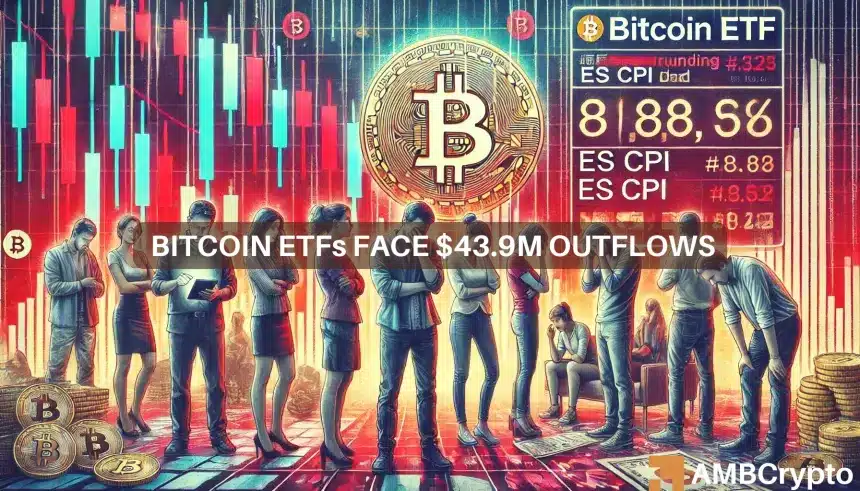Following a period of continuous withdrawals, Bitcoin [BTC] ETFs experienced a brief upturn with inflows observed on the 9th and 10th of September.
However, this surge was short-lived.
Bitcoin ETF Faces Outflow Trends
On September 11th, there was a significant reversal in the trend, marked by net outflows amounting to $43.9 million, as per data from Farside Investors.
This abrupt change put an end to a two-day streak of positive inflows, showcasing the volatile nature of BTC ETF investments amidst the current market conditions.
Interestingly, BlackRock’s IBIT has remained inactive, with zero movement recorded since August 26, except for a notable outflow of $9.1 million on September 9th.
Conversely, Fidelity’s FBTC and Invesco’s BTCO have displayed positive activity, with inflows amounting to $12.6 million and $2.6 million respectively by September 11th.
In a contrasting turn of events, Ark Invest and 21Shares’ ARKB witnessed significant outflows totaling $54.0 million as per Farside Investors’ data.
Additionally, Grayscale’s GBTC reported net outflows of $4.6 million, emphasizing the ongoing volatility and shifting dynamics in the Bitcoin ETF arena.
Ethereum ETF Evaluation
Similarly, Ethereum [ETH] ETFs echoed the recent fluctuations observed in BTC ETFs.
After a period of outflows, ETH ETFs experienced a brief uptick with inflows totaling $11.4 million on September 10th, according to Farside Investors.
Nonetheless, this positive momentum was short-lived, as the subsequent day witnessed a total outflow of $0.5 million.
It is worth noting that while most of the Ethereum ETFs depicted no movement, Fidelity’s FETH noted a modest inflow of $1.2 million, whereas VanEck’s ETHV faced outflows amounting to $1.7 million.
This contrast underlines an unusual pattern where BlackRock’s ETFs have consistently remained stationary, in stark contrast to Fidelity’s ETFs, which have exhibited resilience.
On the pricing front, both Bitcoin and Ethereum experienced declines on September 11th.
However, by September 12th, both cryptocurrencies rebounded, with BTC registering a 3.3% rise and ETH showing a 1.58% increase within a day, as reported by CoinMarketCap.
Underlying Factors
The abrupt variations in ETF flows and cryptocurrency prices could potentially be linked to the recent release of the U.S. Consumer Price Index (CPI) data.
August’s CPI figures revealed a minimal 0.2% uptick in consumer prices, decreasing the 12-month inflation rate to 2.5%—the lowest level since February 2021, as highlighted by CNBC.
This data led Citi to predict a more conservative 25 basis point rate cut at the upcoming Federal Open Market Committee (FOMC) meeting.
Despite this anticipated adjustment, Citi’s analysis indicates that core PCE inflation, a pivotal factor for Fed policy-making, remains stable, signaling a balanced monetary policy approach in the immediate future.
Crypto analyst Rachael Lucas from BTCMarkets aptly expressed, stating,
“The outflows from Bitcoin and Ethereum ETFs are predominantly in response to robust U.S. economic data and should be viewed as a typical phase in the evolution of ETFs.”

